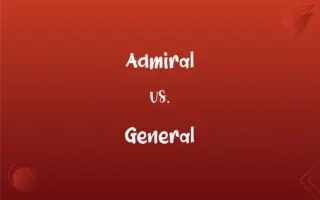Allotropes vs. Isotopes: What's the Difference?
Edited by Aimie Carlson || By Janet White || Published on December 30, 2023
Allotropes are different structural forms of the same element, while isotopes are variants of a chemical element differing in neutron number.

Key Differences
Allotropes are various physical forms in which an element can exist, distinguished by their atomic arrangement. Isotopes, in contrast, are atoms of the same element with different numbers of neutrons and, consequently, different atomic masses.
Examples of allotropes include carbon forms like graphite, diamond, and graphene. For isotopes, hydrogen has variants like protium, deuterium, and tritium, which differ in neutron count.
Allotropes exhibit different physical and chemical properties despite being the same element. Isotopes of an element generally have similar chemical properties but different physical properties, such as radioactive decay behaviors.
The existence of allotropes is due to the different ways atoms can bond in the same element. Isotopes are created either naturally or artificially and are distinguished by their different atomic weights.
In allotropes, the variation is in the atomic bonds and structure, not the atomic composition. In isotopes, the variation lies in the atomic nucleus, specifically the number of neutrons.
ADVERTISEMENT
Comparison Chart
Definition
Different structural forms of the same element.
Variants of an element with different neutron numbers.
Variation
In atomic arrangement and bonding.
In the number of neutrons in the nucleus.
Examples
Carbon as diamond, graphite, graphene.
Hydrogen as protium, deuterium, tritium.
Properties Affected
Physical and chemical properties can differ significantly.
Chemical properties similar, physical properties differ.
Occurrence
Due to different bonding structures in the same element.
Naturally occurring or artificially created.
ADVERTISEMENT
Allotropes and Isotopes Definitions
Allotropes
Variants of an element with different molecular structures.
Oxygen exists as two allotropes: O2 and ozone (O3).
Isotopes
Variants of an element with different numbers of neutrons.
Carbon-12 and Carbon-14 are isotopes of carbon.
Allotropes
Different forms of the same element with different bonding.
Diamond and graphite are allotropes of carbon.
Isotopes
Atoms of the same element having different atomic masses.
Uranium has several isotopes, including U-235 and U-238.
Allotropes
Distinct structural modifications of a chemical element.
Phosphorus has several allotropes, including white and red phosphorus.
Isotopes
Nuclei of an element that have the same atomic number but different mass numbers.
Chlorine has two stable isotopes, Cl-35 and Cl-37.
Allotropes
Physical forms of an element, differing in atomic arrangement.
Graphene, another allotrope of carbon, is known for its strength.
Isotopes
Variants of elements used in radiometric dating.
Carbon-14, an isotope of carbon, is used in carbon dating.
Allotropes
Different crystalline forms of the same pure element.
Sulfur exists in several allotropic forms.
Isotopes
Forms of an element differing in neutron count but same proton count.
Hydrogen's isotopes include protium, with no neutrons.
Allotropes
A structurally differentiated form of an element that exhibits allotropy.
Isotopes
One of two or more atoms having the same atomic number but different mass numbers.
Allotropes
Plural of allotrope
Isotopes
Plural of isotope
FAQs
What are allotropes?
Allotropes are different forms of the same element with varying atomic arrangements.
How do isotopes occur?
Isotopes occur naturally or can be artificially produced, differing in the number of neutrons.
How do allotropes form?
Allotropes form due to different bonding and structural arrangements of atoms in an element.
Are isotopes chemically similar?
Yes, isotopes of the same element generally have similar chemical properties.
What are isotopes?
Isotopes are variants of a chemical element that have different numbers of neutrons.
Can allotropes change into each other?
Yes, allotropes can transform into each other under certain conditions, like heat or pressure.
What is an example of an allotrope?
Graphite and diamond are examples of carbon allotropes.
Are allotropes naturally occurring?
Many allotropes occur naturally, though some can be synthetically created.
What is an example of an isotope?
Protium and deuterium are examples of hydrogen isotopes.
Why are allotropes important?
Allotropes are important because they offer different properties and uses for the same element.
Do allotropes have different physical properties?
Yes, allotropes can have vastly different physical properties.
Are all isotopes stable?
No, some isotopes are unstable and undergo radioactive decay.
What is the significance of oxygen's allotropes?
Oxygen's allotropes, like O2 and ozone (O3), are crucial for life and environmental processes.
Can allotropes have different chemical behaviors?
While chemically the same, allotropes can exhibit different reactivities due to their structure.
How do isotopes affect atomic mass?
Isotopes contribute to the average atomic mass of an element due to their varying mass numbers.
Can allotropes be used in technology?
Yes, allotropes like graphene are used in advanced technological applications.
How are isotopes identified?
Isotopes are identified by their mass number, which is the sum of protons and neutrons.
Why are isotopes important in science?
Isotopes are important for their use in dating, medical diagnostics, and research.
What is isotope fractionation?
Isotope fractionation is the process of separating isotopes of the same element based on mass differences.
Can isotopes be radioactive?
Yes, some isotopes are radioactive, like Carbon-14 and Uranium-238.
About Author
Written by
Janet WhiteJanet White has been an esteemed writer and blogger for Difference Wiki. Holding a Master's degree in Science and Medical Journalism from the prestigious Boston University, she has consistently demonstrated her expertise and passion for her field. When she's not immersed in her work, Janet relishes her time exercising, delving into a good book, and cherishing moments with friends and family.
Edited by
Aimie CarlsonAimie Carlson, holding a master's degree in English literature, is a fervent English language enthusiast. She lends her writing talents to Difference Wiki, a prominent website that specializes in comparisons, offering readers insightful analyses that both captivate and inform.






































































